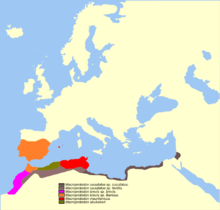Hooded snake
| Hooded snake | ||||||||||||
|---|---|---|---|---|---|---|---|---|---|---|---|---|

Macroprotodon cucullatus |
||||||||||||
| Systematics | ||||||||||||
|
||||||||||||
| Scientific name | ||||||||||||
| Macroprotodon cucullatus | ||||||||||||
| ( Geoffroy-St.-Hillaire , 1827) |
The hooded snake ( Macroprotodon cucullatus ) is a species of the snake (Colubridae). The distribution area extends from the southern Iberian Peninsula and the Balearic Islands across North Africa to Israel . It has furrow teeth in the back of the jaw that are connected to poison glands and is therefore assigned to the non- monophyletic group of snakes .
features
The hooded snake is a small species of snake and reaches an average length of about 40 to 50 cm, large specimens can also be over 60 cm long. The body color is light gray, gray-brown or reddish-brown with a back and flank drawing of indistinct dark spots that can also form stripes. In the neck there is a noticeable dark spot ("hooded spot") which tapers to the front and back and can occupy a large part of the neck or the head. From the nostrils on both sides a temple band extends over the eyes to the corners of the mouth. The ventral side is yellowish-creamy white or light pink to red and has dark spots. The body scales are smooth, so the body looks smooth and shiny.
The flattened head is only slightly separated from the body. The small eyes sit very far in front of the head and have a perpendicular-oval pupil . The snout shield is wide, but very low and hardly visible when viewed from above , there is a rein shield . There are 19 to 25 rows of scales around the middle of the body.
distribution and habitat
The distribution area extends from the southern Iberian Peninsula and the Balearic Islands across North Africa to Israel . Several subspecies are recognized:
- M. c. ibericus - on the southern Iberian Peninsula and the Balearic Islands
- M. c. brevis - West and Central Morocco
- M. c. cucullatus - Central and South Algeria , Tunisia , North Libya , North Egypt and Israel
- M. c. mauritanicus - Eastern Morocco, Northern Algeria, and Northern Tunisia.
As a habitat, the animals colonize dry terrain and scree slopes as well as clearings in the lowlands and hills up to 1,500 m in height. You can also find them in brick walls and dilapidated buildings that they use as shelter.
Way of life
The hooded snake is crepuscular and nocturnal. It mainly hangs out on the ground and during the day hides under stones and in earthworks as well as in crevices and brittle masonry. It hibernates for four to six months.
Their range of prey mainly includes small lizards and geckos . She holds the captured animals in her jaws until the poison of her poisonous teeth, which are located in the back of the rows of teeth, acts and paralyzes or kills the prey.
The snake is egg-laying, the clutch consists of 5 to 7 eggs. The young snakes hatch in late summer and start actively searching for food after the first molt.
Snake venom
Hooded snakes have a poison that is effective for their prey, which they can introduce into a wound via the rear furrow teeth (opistoglyph). The snakes can also bite people, although the poison, which is relatively harmless to humans, is usually not used due to the poisonous teeth that are far back. Bite accidents are also comparatively rare.
Danger
The hooded snake is classified in the IUCN Red List as Least Concern. This is justified by the very large distribution area of the species with an assumed large total population. In addition, the snake is relatively insensitive to changes in the habitat. Locally, however, this species can also be endangered, mainly due to intensification of agriculture and an increase in urbanization. On the island of Lampedusa the number of individuals is falling sharply due to deforestation , in Egypt there is a sharp decline due to the increasing number of catches for the international terrarium trade as well as an increase in tourism and other factors.
supporting documents
Evidence cited
- ↑ a b Macroprotodon cucullatus in the endangered Red List species the IUCN 2006 Posted by: C. Corti, VP Mellado, P. Geniez, SB El Din, 2006. Retrieved on December 26 of 2008.
literature
- Ulrich Gruber: The snakes of Europe. Franckh'sche Verlagsbuchhandlung, Stuttgart 1989; Pages 149–151. ISBN 3-440-05753-4 .
- Axel Kwet: Reptiles and Amphibians of Europe . Franckh'sche Verlagsbuchhandlung, Stuttgart 2005; Page 215. ISBN 3-440-10237-8
